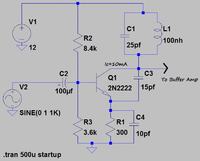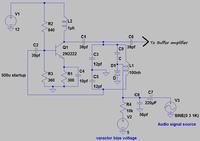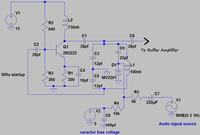aj_silverthunder
Full Member level 3
guys in tthe schematic its a reactance modulation,my confusion is about the output signal from the oscillator,
guys from wich point can i take the output signal from the tank circuit to the next buffer amp stage...in the
schematic,do u think the output can be taken out from under the inductor to the next buffer amp stage,please
help me,its very crucial thing for me now,thank u
i think the output must be from the collector of the transistor,am i right or wrong,if wrong,please correct me,
Added after 24 minutes:

guys from wich point can i take the output signal from the tank circuit to the next buffer amp stage...in the
schematic,do u think the output can be taken out from under the inductor to the next buffer amp stage,please
help me,its very crucial thing for me now,thank u
i think the output must be from the collector of the transistor,am i right or wrong,if wrong,please correct me,
Added after 24 minutes:


